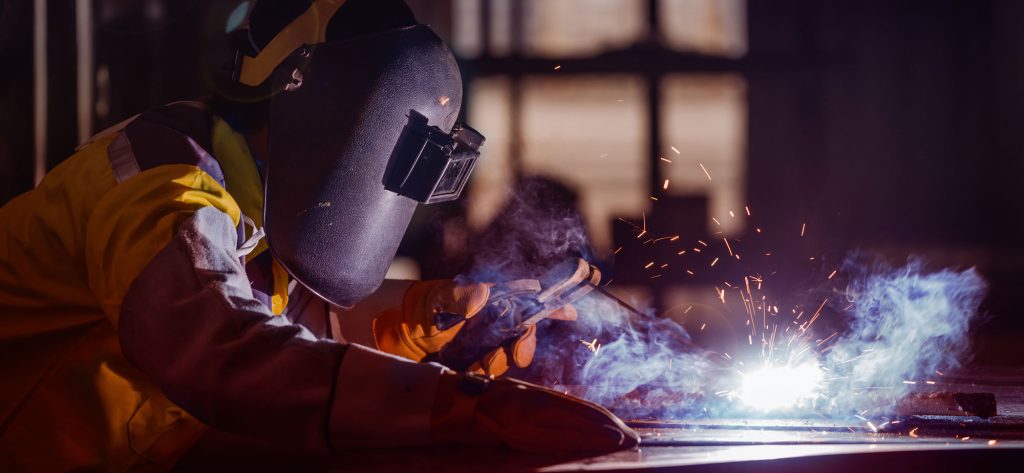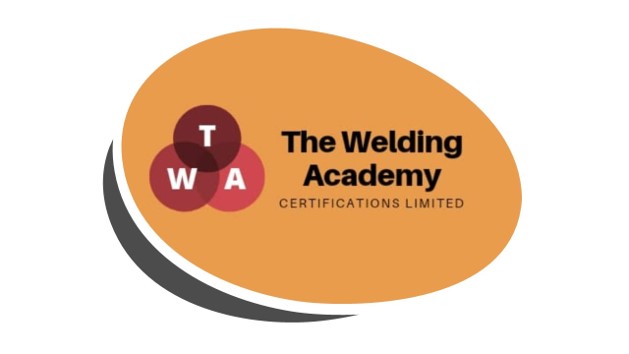Manual Metal Arc Training Notes (MMA or Stick)
4.6/5 stars on Google Reviews
5/5 stars on Facebook Reviews

Manual Metal Arc (MMA) Welding (Stick Welding)
Overview Of MMA Welding
Manual Metal Arc (MMA) welding is also referred to as Stick welding, Arc welding or Shielded Metal Arc Welding (SMAW) depending on how you first heard about welding. MMA is the most versatile of the welding processes and is suitable for welding mild steel and stainless steel for big range of thicknesses. The consumable in this process is an electrode which has a core wire with a flux covering. The electrode sits in an electrode holder held by the operator, the arc is formed by striking the electrode across the metal plate, the metal plate and the electrode melt to form a weld pool. The weld pool is protected by the gas formed from the melting of the flux to protect the initial weld pool and then the formation of slag over the cooling weld. The slag is chipped off when cool to reveal the weld bead.
MMA basic equipment requirements
MMA welding setups are pretty basic and therefore easy to set up and use in a range of environments. MMA welding is usually but not exclusively used for site work with the plant run from a generator. The plan can either be a transformer/rectifier or inverter. The inverter being favoured because of its light design making it easy to transport.
The main components of an MMA welding setup are:
1. The Welding Plant (transformer, inverter or generator)
2. Electrode holder
3. Return cable
4. Electrodes
MMA Electrode Selection
The electrodes are produced in lengths, usually, 300-450mm long and the core wire diameter is typically 2-6mm with a flux covering that might double the overall diameter. There is a large selection of welding electrodes that are on the market. The ones that you might use are dependant on the job to be completed, parent metal, welding position, availability and cost. However, electrodes can be separated into groups based on their flux coatings.
MMA Cellulosic Electrodes
Cellulosic electrodes give a strong arc and penetration. Cellulosic 6010 electrodes are used for DC supply and 6011 are for AC supply. The gas shield generated is carbon monoxide, carbon dioxide and hydrogen, which increase the arc tension giving a 60-70% deeper penetration. Cellulosic coatings are only used on carbon or carbon-manganese steels.
Should not be dried in an oven as they rely on a hydrogen atmosphere to create the shielding and should be used directly from the manufacturer’s packaging. If electrodes have been left exposed and become soaked they should be discarded.
MMA Rutile Electrodes
The coating of rutile electrodes has a high proportion of titanium dioxide. Rutile 6013 electrodes can weld in all positions including vertical, overhead and downhand. 6013 electrodes remain the welders’ choice for general purpose welding having a smooth arc action and good slag release.
Also, require an amount of moisture in them to run correctly as dried rutile rods have a very poor arc action and shielding. If rutile rods become inadvertently wet they can be returned to condition by holding for an hour at around 80°C. Some texts have suggested 120°C but excessive time at such a temperature can easily over-dry the flux.
MMA Basic Electrodes
Electrodes classified as 7016 or 7018 types that can operate on AC and DC supplies. The main difference between E7016 and E7018 electrodes is the iron powder content in the latter. Both give good mechanical properties, especially toughness and low hydrogen weld metal. Basic electrodes are available from many manufacturers in vacuum packs, packed under careful control directly from the baking oven as they are manufactured and hermetically sealed under vacuum so there is no possibility of moisture pick-up. Manufacturers offer a guarantee of low hydrogen performance straight from the package and may give an exposure that is permissible after opening the package whilst still maintaining adequate hydrogen control but once this exposure is exceeded, the rods should be discarded.
Electrode Storage and handling
MMA electrodes are packed in a variety of forms, most common is the packaging of around 5kg of electrodes in thin card packs wrapped in polyethene film, adequate protection in storeroom conditions but permeable to moisture so deterioration can take place in wet environments. Electrodes in packs should always be stored in warm dry stores and manufacturers give specific recommendations on their packages and datasheets.
MMA Welding Process
When an arc is struck between the coated electrode and workpiece, both melt to form a weld pool. The temperature of the arc is sufficient to melt the parent metal, consumable core wire and flux coating simultaneously. The flux forms gas and slag which protect the weld pool from oxygen and nitrogen in the surrounding atmosphere. The molten slag solidifies and cools and must be chipped off the weld bead once the weld run is complete (or before the next weld pass is deposited where multi-run welding is necessary). The process allows only short lengths of weld to be produced before a new electrode needs to be inserted in the holder.
In general, DCEP results in deeper penetration and DCEN has a higher burn-off for a given current resulting in better deposition rate.
A good connection between the workpiece and the earth return to the power source is essential for MMA welding. If the current route is changing across the workpiece, a DC arc may be deflected; residual magnetism in the material may give similar deflection this is called arc blow
MMA Welding Current (Amperage)
The current range required depends on the diameter and type of electrode. Always follow the manufacturer’s recommendation as variation can occur as shown in the table below which cites a few specific electrodes. If the current selected is higher than recommended, the electrode will overheat and towards the end of the run may begin to glow red.
Weld quality is affected by incorrect current settings:
• Current too low – Poor fusion or penetration, irregular weld bead shape, slag inclusions, unstable arc, porosity.
• Current too high – Excessive penetration, burn through, undercut, spatter, porosity, deep craters, electrode damage due to overheating, high deposition making positional welding difficult.
Welding Voltage
For MMA welding the voltage required to initiate the arc is called the open-circuit voltage (OCV), which is the voltage measured between the output terminals of the power source when no current is flowing through the welding circuit. For safety reasons the OCV should not exceed 100V and is usually between 50-90V. Immediately the arc is established a working (arc) voltage of 20-30V is adopted. Arc voltage is a function of arc length which with MMA is controlled by the welder. Arc voltage controls weld pool fluidity.
The effects of the wrong arc length and therefore arc voltage can be:
• Arc voltage too low – Poor penetration, electrode stubbing, lack of fusion defects, slag inclusions, unstable arc condition, irregular weld bead shape.
• Arc voltage too high -Excessive spatter, porosity, arc wander, irregular weld bead shape, slag inclusions, fluid weld pool making positional welding difficult.
Travel speed
Travel speed is the rate of weld progression. Potential defects associated with incorrect welding speeds when using the MMA welding process are:
• Travel speed too fast – Narrow thin weld bead, fast cooling, slag inclusions, undercut, poor fusion/penetration, insufficient heat input giving high hardness structures.
• Travel speed too slow – Cold laps, excess weld deposition, irregular bead shape, undercut, excess heat input making the development of high toughness impossible.
Welding Polarity (a type of current)
Polarity affects the distribution of heat differently in MMA because of the effects of the compounds in the flux. There is evidence that direct current electrode negative (DCEN) can result in higher melting rates in MMA. The preferred polarity of the MMA system depends upon the electrode being used and the desired properties of the weld. Manufacturers have developed coating systems that stabilise the arc in AC, that direct current electrode negative (DCEP) or DCEN. Many electrodes work on more than one polarity and some work successfully on all three.
Not sure which course is right for you?
Call 01244 389155
If you’re not sure which course is right please just get in touch and for a no-obligation discussion about the courses.
Our clients
Fully kitted out welding training centre in Chester, UK
Training is based at our fully kitted out and TWI approved training centre in Chester, in the UK. Although, we can also offer tailored training plans on-site at your business for larger teams with a need for short, intensive training courses.
- Unit 5 Jupiter Drive, Chester West Employment Park, Chester, CH14QS
